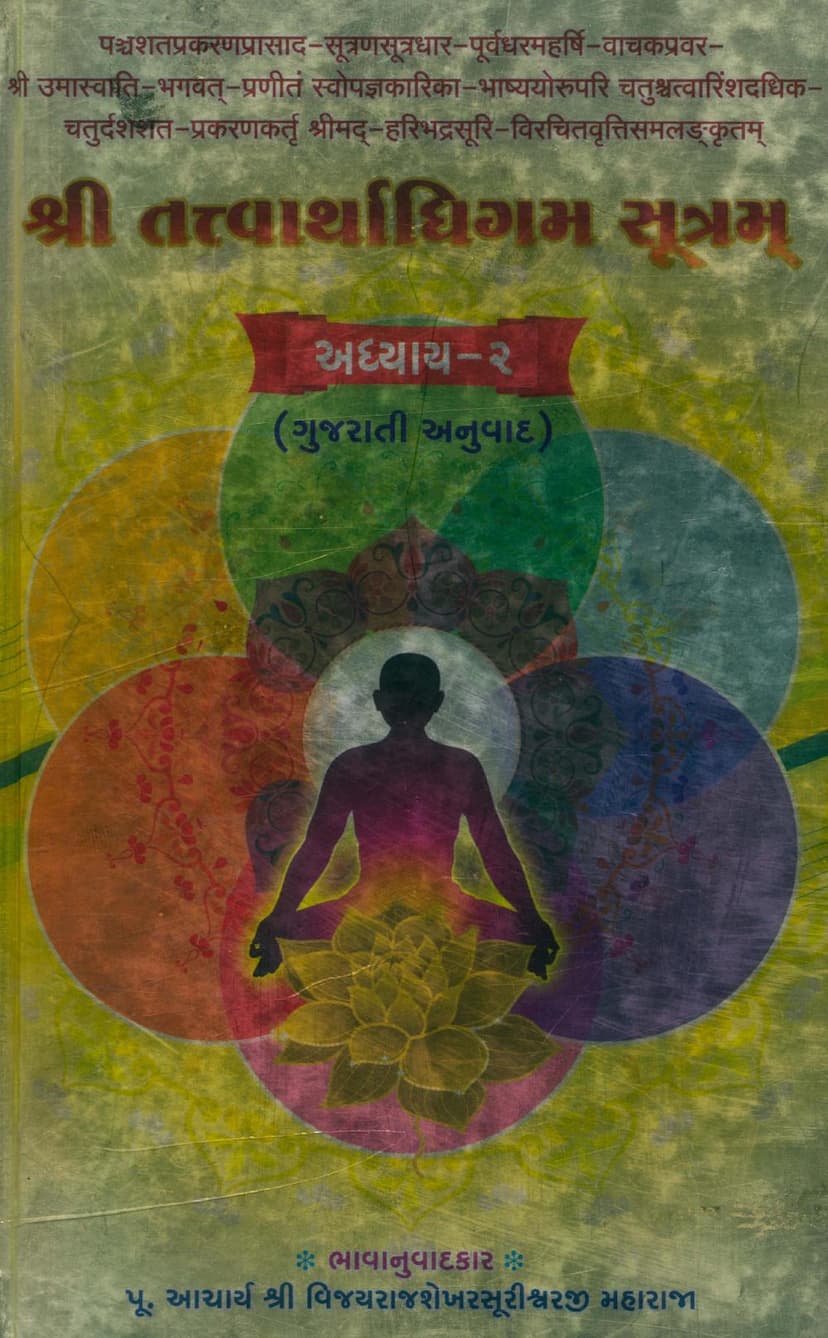Tattvarthadhigam Sutram Part 02
Added to library: September 2, 2025

Summary
Here's a comprehensive summary of the provided Jain text, "Tattvarthadhigama Sutram Part 02," authored by Rajshekharsuri, Dharmshekharvijay, and Divyashekharvijay, published by Arihant Aradhak Trust:
This text is the Gujarati translation and commentary of the second chapter of the Tattvarthadhigama Sutram. The Tattvarthadhigama Sutram is a foundational Jain text, primarily attributed to Umaswati, which explains the essence of Jain philosophy. This particular volume focuses on Chapter 2, which delves into the nature and classification of the soul (Jiva) and its various states and characteristics.
Key Concepts and Content of Chapter 2:
The chapter begins by establishing the fundamental nature of the soul (Jiva) and its various modes of existence. The core of the chapter revolves around the following:
-
The Five Soul States (Bhava): The chapter introduces the five fundamental states or dispositions of the soul:
- Aupashamika (Obscured): States that arise from the suppression (upsham) of karmas.
- Kshayika (Destroyed): States that arise from the complete destruction (kshaya) of karmas.
- Kshayopashamika (Mixed): States that arise from a combination of the destruction and suppression of karmas.
- Audayika (Resultant): States that arise from the fruition (udaya) of karmas.
- Parinamika (Natural/Innate): States that are inherent to the soul's nature, existing from beginningless time.
The chapter details the specific number of sub-categories (bheda) for each of these five states: Aupashamika (2), Kshayika (9), Kshayopashamika (18), Audayika (21), and Parinamika (3). It then systematically explains the constituents of each of these sub-categories, often referring to previous or future chapters for detailed explanations.
-
Soul's Characteristics (Lakshana): The chapter identifies "Upayoga" (Consciousness or Use) as the essential characteristic of the soul. Upayoga itself is divided into two types:
- Jnana Upayoga (Knowledge Consciousness): The consciousness related to knowing. This is further detailed into eight types: four types of correct knowledge (Mati, Shruta, Avadhi, Manahparyaya), three types of incorrect knowledge (Mati-ajñana, Shruta-ajñana, Vibhanga-jñana), and Kevala-jñana (Omniscient Knowledge).
- Darshana Upayoga (Perceptual Consciousness): The consciousness related to perception. This is divided into four types: Chakshu-darshana (vision), Achakshu-darshana (other than vision), Avadhi-darshana (clairvoyant perception), and Kevala-darshana (Omniscient Perception).
-
Classification of Souls: The chapter classifies souls based on their modes of existence and sensory faculties:
- Samsari (Worldly) and Mukta (Liberated): Souls are broadly categorized into those still in the cycle of birth and death and those who have attained liberation.
- Samanaska (with Mind) and Amansaka (without Mind): This classification further divides souls based on the presence or absence of a mind, which is crucial for higher cognitive functions.
- Trasa (Mobile) and Sthavara (Immobile): Souls are classified based on their ability to move. Trasa souls are further categorized by their number of senses (Indriyas).
-
The Five Senses (Indriyas): The chapter details the five senses:
- Dravya Indriya (Material Sense): The physical sense organs, which are further divided into Nirvritti (the inherent sense organ) and Upakarana (the functioning instrument).
- Bhava Indriya (Functional Sense): The functional aspect of the senses, which comprises Labdhi (the potential to sense) and Upayoga (the actual act of sensing).
- The chapter lists the specific objects of each sense: Sparsha (touch), Rasa (taste), Gandha (smell), Varna (color/form), and Shabda (sound). It also clarifies that Shruta (scriptural knowledge) is the object of the mind.
-
Types of Birth and Bodies: The chapter explains the different types of birth and the corresponding bodies:
- Birth Types: Sammūrchana (spontaneously generated), Garbha (gestated), and Upapata (celestial/hellish birth).
- Body Types: Audarika (gross physical body), Vaikriya (transformable body), Aharaka (carrying body), Taijasa (fiery/light body), and Karmamana (karmic body). The chapter discusses their relative subtlety, their origin, and their relationship to different birth types. For instance, Audarika is associated with Garbha and Sammūrchana births, Vaikriya with Upapata births and those with specific powers, and Aharaka is associated with fourteen Purva-holders.
-
Life Span (Ayushya) and its Modifications: The chapter touches upon the nature of life span, categorizing it as either inviolable (Anapavartaniya) or violable (Apavartaniya). It discusses how certain actions or conditions can modify the duration of life, a concept illustrated with analogies like burning a haystack. It also highlights that certain souls, like those in higher realms or those with specific innate characteristics, have inviolable lifespans.
-
The Five Bodies: The text elaborates on the five types of bodies, discussing their formation, subtlety, and existence across different types of souls and realms. It emphasizes that Taijasa and Karmamana bodies are fundamental and present in most sentient beings throughout their transmigration, while other bodies are acquired based on the soul's state and actions.
Commentary and Translation Aspects:
- The text is a Gujarati translation and commentary (Bhavanuvaad) by Pujya Acharya Shri Vijay Rajshekharsurishwarji Maharaj.
- The work acknowledges the foundational Tattvarthakärikä and Bhashya by Umaswati, and the commentary by Haribhadrasuri.
- The introduction and explanations provide context, define key terms, and address potential queries or interpretations, often referencing other Jain scriptures and previous scholarly works.
- The translation aims to make the profound philosophical concepts accessible to Gujarati-speaking readers, reflecting the author's extensive literary contributions to Jain literature.
- The text also includes acknowledgments and remembrances of contributing Munis and scholars, highlighting the collaborative effort involved in producing such a work.
In essence, this volume provides a detailed exposition of the second chapter of the Tattvarthadhigama Sutram, offering insights into the soul's states, characteristics, classifications, and the nature of its physical manifestations (bodies) within the Jain cosmological framework, all presented through a clear Gujarati translation and commentary.